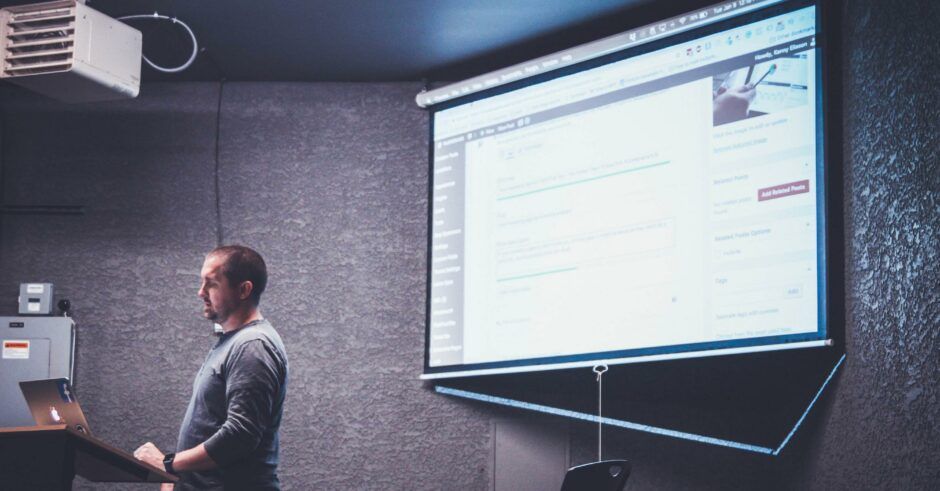It’s hard to imagine the business world today without PowerPoint. From product launches to sales pitches, PowerPoint is a useful tool with many applications. Yet, when it comes to e-learning, you may be surprised to learn that PowerPoint is far from the most effective method for presenting information.
This article explores why that is, and explains how getting beyond the PowerPoint mindset will improve your e-learning content and lead to better learning outcomes.
Are you stuck in PowerPoint mode?
When you or your colleagues are authoring an e-learning course, do you feel the need to create a slide-by-slide PowerPoint presentation? Are you building the kind of presentation you would create if you were going to stand up in front of a group of trainees and lecture them? Perhaps you’re even simply migrating actual PowerPoint presentations into your e-learning platform?
These might seem like logical things to do. After all, we’ve all been to countless training sessions where a trainer clicks through a PowerPoint presentation one slide at a time, giving a lecture as they go.
What’s wrong with this? The problem is that while PowerPoint is great for a one-sided presentation, where a speaker does all the talking, it’s actually not very good at engaging learners. Engagement requires interactivity and a degree of learner autonomy so that learners take an active role and acquire knowledge organically at their own pace.
It’s also very important to avoid overloading your learners with content. PowerPoint often involves lots of text and information on each slide. This is a big turn-off if you’re trying to keep your learner’s attention.
Going from PowerPoint to e-learning
If you want learners to really acquire the information you’re “presenting” to them, it’s much more effective to provide information using interactive, engaging methods. These methods include quiz questions (of which there are many types to choose from), bite-sized nuggets of microlearning content delivered on a mobile device, and instant feedback, supplied automatically in response to the learner’s actions. These are just a few of the options that a modern e-learning platform like Easygenerator can offer. They make the learning process far more engaging and effective than a dense, one-sided presentation.
In fact, while training with PowerPoint can often feel like a boring, passive experience for learners, acquiring knowledge through interactive e-learning software is usually perceived as much more fun and engaging. That’s exactly the kind of learning experience that you want to provide to ensure your learners get the most out of the training experience.
How can you get past the PowerPoint mindset?
The key to shedding old PowerPoint habits is to create courses in the right order. The correct order for writing any e-learning course, whether you’re using Easygenerator or another authoring tool, should be as follows:
- Define your learning objectives
- Formulate your assessment
- Create content
Let’s look at these three steps in more detail:
1. Defining learning objectives
Before you sit down and start writing pages of text about the training topic, narrow in specifically on what you want to achieve. Ask yourself: what new knowledge or skills should the learner acquire by taking this e-learning course? Be as specific and realistic about the objectives as possible. The more precise, the better.
If you’re having a hard time coming up with clear learning objectives, be sure to check out this article which gives you some useful tips. The Easygenerator Learning Objective Maker will also help you define clear, high-impact learning objectives, based on Bloom’s Taxonomy.
2. Formulating assessments
Once you know what your learning objectives are, use them to guide you towards the kind of assessment you want your learners to answer. After all, completing an assessment correctly is the best way for the learner to demonstrate that he or she has acquired the knowledge or skills that are expected of them.
Often, the assessment will be in the form of a test. That means the learner will need to either answer questions or perform an action correctly to demonstrate he or she has gained the necessary knowledge or skill. Focusing on your learning objectives for the course, think of what the learner will need to do successfully to show that they now have the knowledge or skill you’re trying to teach them.
3. Creating content
Now, you’re ready to write the content. Be sure that the content clearly states the learning objectives from the beginning and is geared specifically towards successfully completing the assessment. By limiting your content only to that specific information, you’re sure to avoid PowerPoint-style cognitive overload and achieve the learning objectives you set out to achieve.
An interactive learning experience
Now that you know the right steps to follow, you’re ready to move beyond passive, content-heavy PowerPoint-style training and enter the world of interactive, effective e-learning. And with a user-friendly authoring tool like Easygenerator, you and the subject matter experts in your company will be turning out high-quality, engaging e-learning content in no time.
The Business Transformation Network have shared this article in partnership with easygenerator.




